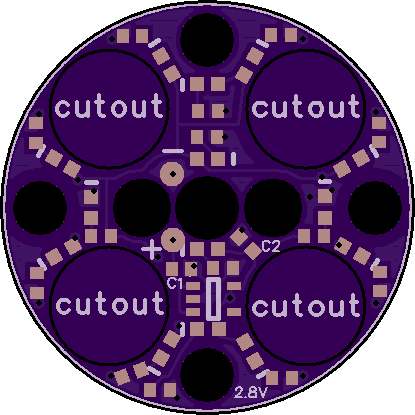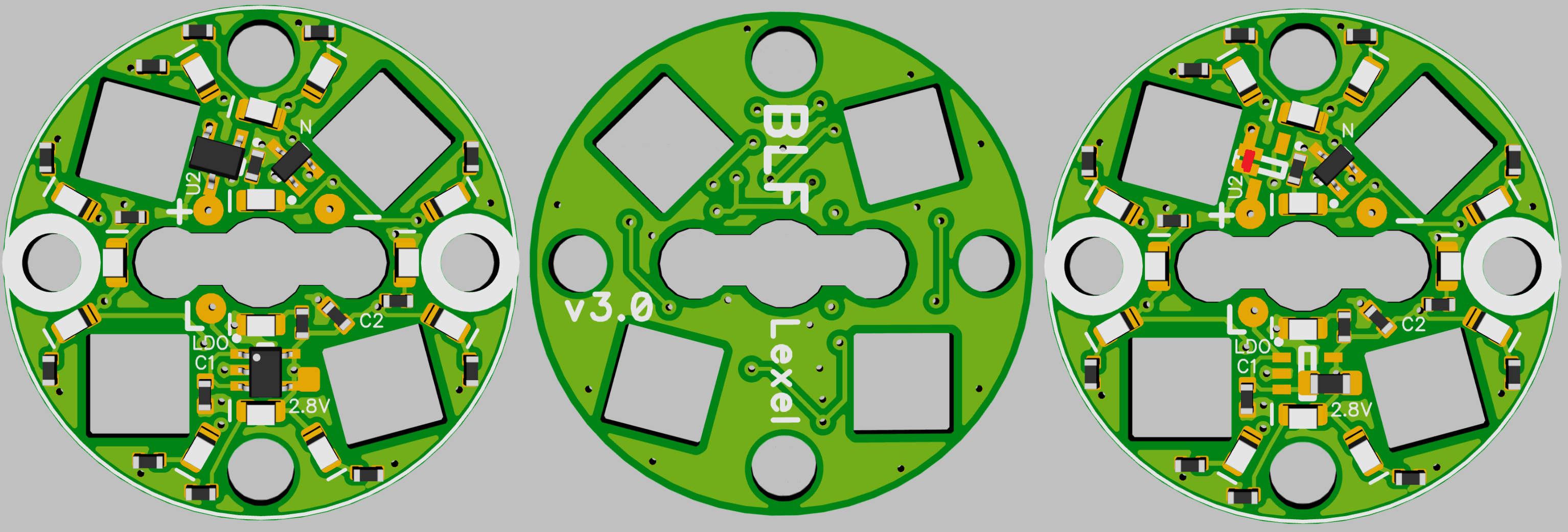You’re probably spot on…apologies for jumping on you Lexel.
I could not find a source for the battery in Canada, the new battery postal rules make shipping into Canada too difficult it seems. The super capacitor I’m using works really good for the first ten minutes and after thirty minutes the output has really dropped off. Its fine most of the time and I don’t have to worry about over discharging the battery. I see a lot of uses for this new driver you made, especially if it can handle higher voltages. Would two amps at 4S and 0.5 amp at 5S be possible? The microphone might be the best part. I don’t know how well Atmega’s can recognize words but if it can identify the word “Beetlejuice” (its a silly movie from long ago) and go into a crazy strobe mode if it hears that word three times I’ll probably have to build four.
Unfortunately the Atmega328 isn't powerful enough to run a voice recognition engine... but would not be hard to make it responds to claps or loud single sounds (again I'm not sure if I recommend this because you certainly don't want to turn this one when it's in your bag for example).
However, you are tempting me to throw in an ARM Cortex M4 on the flashlight and run a voice recognition engine on board... there's certainly enough space ;)
Program the modes with morse code
I myself did the first D4 Aux board with not cut through holes

It just was not so easy to solder the LED wires, even with 0.6mm thin boards, having resistors there that may short out with bad solder skills or equipment isn’t helping
I placed even LVP chip and low side N-FET on it with 0402 resistors with no issues, just route a ring on top side with resistors and back side with LED-

looking on a flashlight with Infineon FET that part is not a weak link, probably even the MCPCB is worse
so many resistances adding up
- springs (even bypassed),
- wires,
- MCPCB,
- copper on driver,
- FET,
- tail board,
- tube
- soldering
This is more and more interesting! just not too long ago having 1000 lumen in a flashlight is next level. today we have possibility of 100w boost driver and now this one with audio reaction.
loneoceans I will plan to build one of this when your design is ready! I hope it will fit new emisar flashlight! (d4 vers 2)
I guess not long before Lexel copy this driver and offer one with similar design! Let see if lexel will suddenly have charge pump on his fet driver and make a fet and cc driver…
However, you are tempting me to throw in an ARM Cortex M4 on the flashlight and run a voice recognition engine on board… there’s certainly enough space
I’m not sure a tiny microphone hidden inside a light would be sensitive enough to work. I don’t know much about ARM’s either, were some of the M4’s IOT capable? Maybe a cell phone could recognize the words and command the driver.
I know its totally off topic but I am curious about your Tesla coils. Do you touch the high voltage, use it to light up fluorescent lamps you are holding or just stay back and watch the light show?
Nicely done, LO. I love to see outside-the-box ideas.
What chip did you use for controlling the FET in CC mode? I assume the FET will be burning off the excess voltage and that a good thermal path for it is essential.
Just throwing this out there… Are there any FETs with an electrically neutral thermal pad? I’ve never seen one, but I haven’t looked that hard.
Just throwing this out there… Are there any FETs with an electrically neutral thermal pad? I’ve never seen one, but I haven’t looked that hard.
Skip that step and put the FET on MCPCB like L4P.
Program the modes with morse code
Great idea. It could be like programming BOSS flashlighs but with the sound instead of light!
Wouldn’t sound pretty. Unless the stream would be steganographically embedded in music. Then programming would take looong. But would be pleasant. ![]()
You had me at:
Very low dedicated Firefly mode.
That’s the ONLY thing missing in the D4 IMO.
Fuggin’ ’ell, YAY :heart_eyes: ![]()
Thanks everyone again for your kind words.
I don't claim to have the skills to be able to implement a neural network on a micro, but fortunately, lots of other people are. Here's an example: https://github.com/ARM-software/ML-KWS-for-MCU. Should be able to get this to run on a Cortex M4 core. But let's not get ahead of ourselves; maybe a future project, but definitely not for this one right now! ![]()
Unfortunately it would be hard to add phone connection to the driver (e.g. via bluetooth), mostly because of how the driver is completely surrounded by metal, and a bit too much time needed to write the firmware for both the driver and the phone~
Anyway I hope this driver will be useful in the end since the main useful features are the constant current drive mode, good temperature regulation, good firefly mode, aux led control, and a little bit of fun with the microphone. The DD FET mode is impractical in my opinion, just a for-fun thing, and optional to even install that half of the driver.
The maximum sustained thermal load the D4 can sink will lead to only a few hundred lumens output.
@gchart, this means thermal sinking of the CC FET is not as crucial as one may think. That said, I found a perfect silicone pad to interface between the fet body and the metal D4 shelf, so thermal sinking is decent.
@i42dk, glad this feature is something you like.
@WTF, yes my main hobby is in big power electronics. For my coils, I'm just standing back to enjoy the show, and to keep safe. They do light up fluorescent bulbs and other low-pressure tubes from a distance though!
Have a great day everyone!
Very interesting and inovative linear driver. But I have one question whats mean no-nonsense linear drive. You just no use a sense resistor for current measurements? What method do you use for current measurements. Maybe you just measure the Rdson of the MOSFET via voltage drop. Also do you use dedicated Charge pump IC for mosfet driver, I assume you also use some sort of transistors driver to turn on power MOSFET. Most of charge pump IC only have 2X of input voltage so it is interesting how do you boost voltage to 10V from single battery.
Very interesting and inovative linear driver. But I have one question whats mean no-nonsense linear drive. You just no use a sense resistor for current measurements? What method do you use for current measurements. Maybe you just measure the Rdson of the MOSFET via voltage drop. Also do you use dedicated Charge pump IC for mosfet driver, I assume you also use some sort of transistors driver to turn on power MOSFET. Most of charge pump IC only have 2X of input voltage so it is interesting how do you boost voltage to 10V from single battery.
ha i think loneoceans mean ‘no nonsense’ meaning it is a linear constant current driver that just works without trouble. I think i see sense resistor in the photograph which is R1.
also my guess is loneoceans using some charge pump gate drive ic like this one: https://www.analog.com/media/en/technical-documentation/data-sheets/19812fs.pdf. for example it has charge pump with “internal voltage tripler allows gates to be driven without the use of any external components.” This explain 10v from one cell, but maybe not this ic since it has 7.5V max, but still good enough!
Thanks.
For lower cost of driver to make a cheap charge pump we can use something like these EEVBlog #473 - Microcontroller Voltage Doubler - YouTube
But integrated method with mosfet driver IC is better but there is no so many chips which to operate at lower power supply voltages like these LTC driver which also have a integrated charge pump.
IMO, I think the main limiting factor of such low resistance drivers are the contacts.
It’s not too much of a problem with FET drivers(unless you want absolute maximum output), but with boost drivers like the other lonoceans made, contacts with removable cells are a large bottleneck.
..
However, you are tempting me to throw in an ARM Cortex M4 on the flashlight and run a voice recognition engine on board... there's certainly enough space ;)
Hmmm. Alexa and Cortana are taken... How about
Emisar Nightlight
or
Emisar Ignite
or....
As Lexel write there are another limiting current resistances, like PCB copper thickness, pcb width traces must be huge for lower resistance and so on. It will be interesting to view how much power PCB board can dissipate from MOSFET to host which is main limiting factor for that driver. For best results the board must be 4 layer design and small thickness. So that driver is very similar as Texas Commander approach from 2 years ago Texas Commander "TC" Constant current Opamp driver without PWM . Aslo very interesting project which has been abandoned for thermal issues with heat dissipation.
One way to do this would be to use thermal adhesive/a PCM material to transfer the heat from the chip to the light.
One way to do this would be to use thermal adhesive/a PCM material to transfer the heat from the chip to the light.
Anyway I hope this driver will be useful in the end since the main useful features are the constant current drive mode, good temperature regulation, good firefly mode, aux led control, and a little bit of fun with the microphone. The DD FET mode is impractical in my opinion, just a for-fun thing, and optional to even install that half of the driver.
The maximum sustained thermal load the D4 can sink will lead to only a few hundred lumens output.
@gchart, this means thermal sinking of the CC FET is not as crucial as one may think. That said, I found a perfect silicone pad to interface between the fet body and the metal D4 shelf, so thermal sinking is decent.
looking forward to see how this driver will do, it seem like loneoceans has thought about thermal since it seem like he chose fet for lowest junction to case thermal, and he mentioned some silicone thermal pad to interface fet body and metal shelf like you suggest blueswordM!